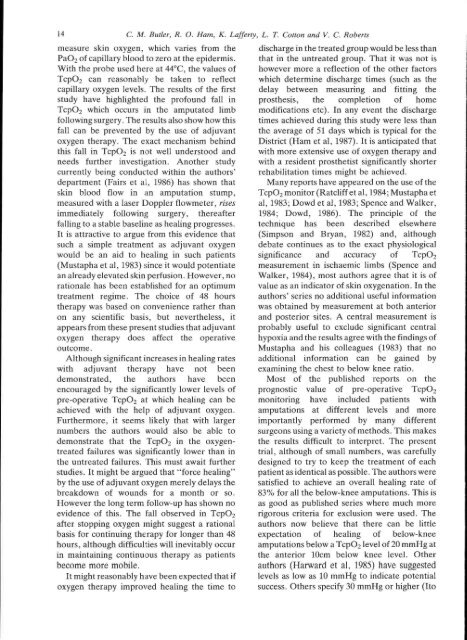View Complete Issue PDF
View Complete Issue PDF
View Complete Issue PDF
You also want an ePaper? Increase the reach of your titles
YUMPU automatically turns print PDFs into web optimized ePapers that Google loves.
measure skin oxygen, which varies from the<br />
PaO 2<br />
of capillary blood to zero at the epidermis.<br />
With the probe used here at 44°C, the values of<br />
TcpO 2<br />
can reasonably be taken to reflect<br />
capillary oxygen levels. The results of the first<br />
study have highlighted the profound fall in<br />
TcpO 2<br />
which occurs in the amputated limb<br />
following surgery. The results also show how this<br />
fall can be prevented by the use of adjuvant<br />
oxygen therapy. The exact mechanism behind<br />
this fall in TcpO 2<br />
is not well understood and<br />
needs further investigation. Another study<br />
currently being conducted within the authors'<br />
department (Fairs et al, 1986) has shown that<br />
skin blood flow in an amputation stump,<br />
measured with a laser Doppler flowmeter, rises<br />
immediately following surgery, thereafter<br />
falling to a stable baseline as healing progresses.<br />
It is attractive to argue from this evidence that<br />
such a simple treatment as adjuvant oxygen<br />
would be an aid to healing in such patients<br />
(Mustapha et al, 1983) since it would potentiate<br />
an already elevated skin perfusion. However, no<br />
rationale has been established for an optimum<br />
treatment regime. The choice of 48 hours<br />
therapy was based on convenience rather than<br />
on any scientific basis, but nevertheless, it<br />
appears from these present studies that adjuvant<br />
oxygen therapy does affect the operative<br />
outcome.<br />
Although significant increases in healing rates<br />
with adjuvant therapy have not been<br />
demonstrated, the authors have been<br />
encouraged by the significantly lower levels of<br />
pre-operative TcpO 2<br />
at which healing can be<br />
achieved with the help of adjuvant oxygen.<br />
Furthermore, it seems likely that with larger<br />
numbers the authors would also be able to<br />
demonstrate that the TcpO 2<br />
in the oxygentreated<br />
failures was significantly lower than in<br />
the untreated failures. This must await further<br />
studies. It might be argued that "force healing"<br />
by the use of adjuvant oxygen merely delays the<br />
breakdown of wounds for a month or so.<br />
However the long term follow-up has shown no<br />
evidence of this. The fall observed in TcpO 2<br />
after stopping oxygen might suggest a rational<br />
basis for continuing therapy for longer than 48<br />
hours, although difficulties will inevitably occur<br />
in maintaining continuous therapy as patients<br />
become more mobile.<br />
It might reasonably have been expected that if<br />
oxygen therapy improved healing the time to<br />
discharge in the treated group would be less than<br />
that in the untreated group. That it was not is<br />
however more a reflection of the other factors<br />
which determine discharge times (such as the<br />
delay between measuring and fitting the<br />
prosthesis, the completion of home<br />
modifications etc). In any event the discharge<br />
times achieved during this study were less than<br />
the average of 51 days which is typical for the<br />
District (Ham et al, 1987). It is anticipated that<br />
with more extensive use of oxygen therapy and<br />
with a resident prosthetist significantly shorter<br />
rehabilitation times might be achieved.<br />
Many reports have appeared on the use of the<br />
TcpO 2<br />
monitor (Ratcliff et al, 1984; Mustapha et<br />
al, 1983; Dowd et al, 1983; Spence and Walker,<br />
1984; Dowd, 1986). The principle of the<br />
technique has been described elsewhere<br />
(Simpson and Bryan, 1982) and, although<br />
debate continues as to the exact physiological<br />
significance and accuracy of TcpO 2<br />
measurement in ischaemic limbs (Spence and<br />
Walker, 1984), most authors agree that it is of<br />
value as an indicator of skin oxygenation. In the<br />
authors' series no additional useful information<br />
was obtained by measurement at both anterior<br />
and posterior sites. A central measurement is<br />
probably useful to exclude significant central<br />
hypoxia and the results agree with the findings of<br />
Mustapha and his colleagues (1983) that no<br />
additional information can be gained by<br />
examining the chest to below knee ratio.<br />
Most of the published reports on the<br />
prognostic value of pre-operative TcpO 2<br />
monitoring have included patients with<br />
amputations at different levels and more<br />
importantly performed by many different<br />
surgeons using a variety of methods. This makes<br />
the results difficult to interpret. The present<br />
trial, although of small numbers, was carefully<br />
designed to try to keep the treatment of each<br />
patient as identical as possible. The authors were<br />
satisfied to achieve an overall healing rate of<br />
83% for all the below-knee amputations. This is<br />
as good as published series where much more<br />
rigorous criteria for exclusion were used. The<br />
authors now believe that there can be little<br />
expectation of healing of below-knee<br />
amputations below a TcpO 2<br />
level of 20 mmHg at<br />
the anterior 10cm below knee level. Other<br />
authors (Harward et al, 1985) have suggested<br />
levels as low as 10 mmHg to indicate potential<br />
success. Others specify 30 mmHg or higher (Ito
















